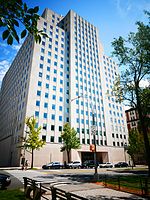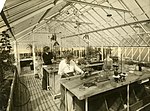Riverside Church

Riverside Church is an interdenominational church in the Morningside Heights neighborhood of Manhattan, New York City, on the block bounded by Riverside Drive, Claremont Avenue, 120th Street and 122nd Street near Columbia University's Morningside Heights campus and across from Grant's Tomb. It is associated with the American Baptist Churches USA and the United Church of Christ. The church was conceived by philanthropist businessman and Baptist John D. Rockefeller Jr. in conjunction with Baptist minister Harry Emerson Fosdick as a large, interdenominational church in Morningside Heights, which is surrounded by academic institutions. The original building opened in 1930; it was designed by Henry C. Pelton and Allen & Collens in the Neo-Gothic style. It contains a nave consisting of five architectural bays; a chancel at the front of the nave; a 22-story, 392-foot (119 m) tower above the nave; a narthex and chapel; and a cloistered passageway that connects to the eastern entrance on Claremont Avenue. Near the top of the tower is the church's main feature, a 74-bell carillon—the heaviest in the world—dedicated to Rockefeller Jr.'s mother Laura Spelman Rockefeller. A seven-story wing was built to the south of the original building in 1959 to a design by Collens, Willis & Beckonert, and was renamed for Martin Luther King Jr. in 1985. The Stone Gym to the southeast, built in 1915 as a dormitory, was designed by Louis E. Jallade and was converted to a gymnasium in 1962. Riverside Church has been a focal point of global and national activism since its inception, and it has a long history of social justice in adherence to Fosdick's original vision of an "interdenominational, interracial, and international" church. Its congregation includes members of more than forty ethnic groups. The church was designated as a city landmark by the New York City Landmarks Preservation Commission in 2000 and was listed on the National Register of Historic Places in 2012.
Excerpt from the Wikipedia article Riverside Church (License: CC BY-SA 3.0, Authors, Images).Riverside Church
Riverside Drive, New York Manhattan
Geographical coordinates (GPS) Address External links Nearby Places Show on map
Geographical coordinates (GPS)
| Latitude | Longitude |
|---|---|
| N 40.811944444444 ° | E -73.963055555556 ° |
Address
Riverside Church
Riverside Drive
10115 New York, Manhattan
New York, United States
Open on Google Maps








